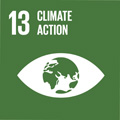- Docente: Stefano Del Duca
- Credits: 6
- SSD: BIO/01
- Language: English
- Teaching Mode: Traditional lectures
- Campus: Bologna
- Corso: First cycle degree programme (L) in Biology of Human and Environmental Health (cod. 5909)
-
from Sep 26, 2024 to Jan 14, 2025
Learning outcomes
At the end of the course, students will have acquired knowledge on the main morphological, physiological and molecular responses of higher plants to environmental cues and the basic mechanisms of tolerance and adaptation to adverse conditions. They will learn about how plants contribute to air quality by the release of biotic particulates and by interfering with air pollutants derived from anthropogenic activities. Due to changes in plant distribution in relation to climate change, students shall become acquainted with the contribution of alien species to the release of such biotic particulates. Students will also learn about methods employed in aerobiology for the quantitative and qualitative assessment of pollen and other air-borne allergens. They will gain the capacity to interpret data and critically read scientific literature relating to this topic. They will also acquire knowledge on the ability of plants to monitor environmental quality and influence it, on the release of volatile plant compounds with therapeutic effects as well as on the possible use of plants in environmental phytoremediation. Additionally, students in the laboratory will acquire methods to analyse plant allergenic proteins, to monitor the effect of stress on photosynthetic activity; in addition, students will analyse an aerobiological sample, allowing them to know that a myriad of microorganisms and particulates (many of which are respirable) are present in the atmosphere
Course contents
Module 1 Plant Human and Environment Interactions (5 CFU + 1 lab)
Synthetic description of the anatomy and cytology of plants. Plant adaptation strategies to different environmental conditions. Plant response strategy to abiotic and biotic stress. Natural products. Alien plants Aerobiology. Pollen and pollination. Main airborne bio-allergens: pollen and fungi. Food allergens of plant origin and respiratory allergens of pollen origin. Role of plants as organisms capable of monitoring environmental quality and influencing it through the release of airborne biological material such as pollen. Volatile compounds of plants with therapeutic effect. Possible use of plants in environmental phytoremediation.
Laboratory activities:
1. Microscopic recognition of aerobiological slide: allergenic and non-allergenic pollen
2. Western blotting/dot blotting for apple and pollen allergenic proteins
3. Pollen-fruit cross-reactivity with specific Ab and comparison with non-cross-reactive pollen/food
4. Handy-Pea: evaluation of photosynthetic activity in stressed and non-stressed plants (e.g. plants maintained at 4 °C)
Readings/Bibliography
Articles in international journals
Teaching methods
Lectures and practical activity in laboratory
Assessment methods
Multiple choice test with 6 questions; each question contains 4 answers, among which the student must select the correct one (s); then follows a question about the program
Written presentation based on recent scientific article inherent to course topics and oral discussion
Teaching tools
Power point lessons will be available online
Office hours
See the website of Stefano Del Duca
SDGs



This teaching activity contributes to the achievement of the Sustainable Development Goals of the UN 2030 Agenda.
